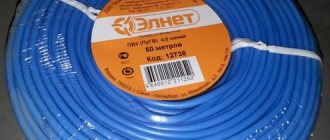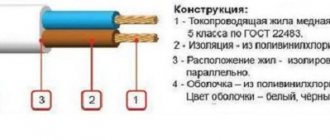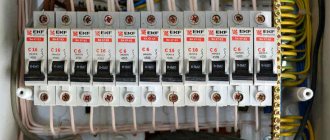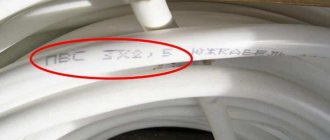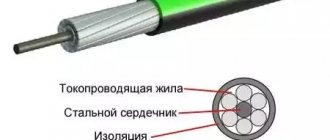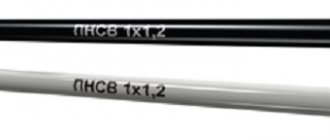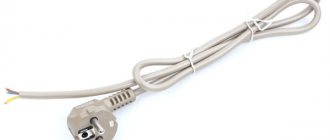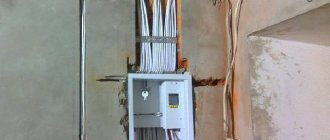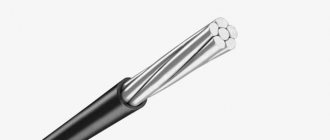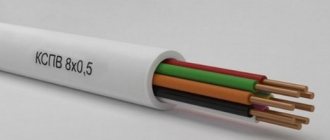Operating and installation conditions for SIP-4 4x10:
— Type of climatic modification of wires B, placement categories 1, 2 and 3 according to GOST 15150-69; — SIP wires 4 4x10 are resistant to bending at temperatures: up to -40°C; — Laying and installation of SIP 4 4x10 wires must be carried out at an ambient temperature of: not lower than - 20°C; — Allowable forces in the zero load-bearing core during tension and operation should not exceed: 45 N/mm2; — SIP 4 4x10 wires after exposure to water at a temperature of (20+10) °C for at least 10 minutes must withstand an alternating voltage test at a frequency of 50 Hz for at least 5 minutes at the construction length: • self-supporting insulated with cross-linked polyethylene - 4 kV ; • self-supporting insulated with thermoplastic polyethylene and flame retardant polyethylene composition – 2.5 kV; — Operation of SIP 4 4x10 wires at temperatures from - 60°C to + 50°C.
Standard sizes
Area of the main cores and permissible current loads for them:
- 16 mm2 - 100 A;
- 25 mm2 - 130 A;
- 35 mm2 - 160 A;
- 50 mm2 - 195 A;
- 70 mm2 - 240 A;
- 95 mm2 - 300 A;
- 120 mm2 - 340 A;
- 150 mm2 - 380 A;
- 185 mm2 - 436 A;
- 240 mm2 - 515 A;
Current loads are indicated for an air temperature of 25 °C, wind speed of 0.6 m/s and ultraviolet radiation of 1000 W/m2; for other conditions, correction factors are applied.
The cross-section of the load-bearing core has an area (in mm2):
- 25;
- 35;
- 50;
- 70;
- 95
Table 1. Brief technical characteristics of SIP wires
| Wire brand | SIP-1 | SIP-2 | SIP-3 | SIP-4 | SIP-5 |
| Number of current-carrying cores, pcs | 1 ÷ 4 | 1 ÷ 4 | 1 | 2 — 4 | 2 — 4 |
| Core cross-section, mm2 | 16 ÷ 120 | 16 ÷ 120 | 35 ÷ 240 | 16 ÷ 120 | 16 ÷ 120 |
| Zero core, bearing | aluminum alloy (with steel cores) | aluminum alloy (with steel cores) | absent | absent | absent |
| Conductor | aluminum | aluminum | aluminum alloy (with steel cores) | aluminum | aluminum |
| Voltage class, kV | 0.4 ÷ 1 | 0.4 ÷ 1 | 10 ÷ 35 | 0.4 ÷ 1 | 0.4 ÷ 1 |
| Core insulation type | thermoplastic polyethylene | light stabilized polyethylene | light stabilized polyethylene | thermoplastic polyethylene | light stabilized polyethylene |
| Operating temperature | -60оС ÷ +50оС | -60оС ÷ +50оС | -60оС ÷ +50оС | -60оС ÷ +50оС | -60оС ÷ +50оС |
| Permissible heating of cores during operation | +70оС | +90оС | +70оС | +90оС | +90оС |
| min wire bending radius | not less than 10 Ø | not less than 10 Ø | not less than 10 Ø | not less than 10 Ø | not less than 10 Ø |
| Life time | at least 40 years | at least 40 years | at least 40 years | at least 40 years | at least 40 years |
| Application |
| — | — for installation of overhead lines with voltage 10-35 kV |
| — |
Description of aluminum wire SIP-4 2x25:
| Options | Description | |
| Number of cores Core material Core type Class | 2 aluminum compacted stranded stranded | |
| Insulation material | light-stabilized polyethylene | |
| Current load (A) | 95 | |
| Permissible current strength of 1-second short circuit, kA | no higher than 1.5 | |
| Twist pitch, mm | no more than 437 | |
| D wire(mm) | 17.5 | |
| Section (mm²) | 25 | |
| Weight (kg\km) | 202 | |
| Maximum winding per drum, m | ||
| №8 | 212 | |
| №10 | 774 | |
| №12 | 1396 | |
| №14 | 2288 | |
| №16 | 3606 | |
| №18 | 5184 | |
| №20 | 5918 | |
| №22 | 7365 | |
Application of SIP-4 2*25
The main task that is solved using the SIP-4 2*25 cable is connecting private facilities from power lines. Using this brand of cable, as a rule, a voltage of 220 V is supplied to the wall of the house. Used in the private sector, in gardening partnerships, and stand-alone production facilities. The connection takes place over the air. Various climatic versions of the cable suggest its wide application. The use of a certain brand of SIP-4 2*25 is regulated by GOST 15150-69. When laying through the air, it does not require a tension cable - the cable is self-supporting. It resists icing well and can work when wires overlap.
Performance
Structurally, the self-supporting cable SIP-4 2*25 consists of two stranded cores. Each core is twisted to the right with a constant pitch. This cable is anti-vandal, since the aluminum alloy of the cores disintegrates when the insulation is fired and cannot be sold for scrap. The core insulation is made of special light-repellent polyethylene. There is no outer shell. Insulating polyethylene has a special color or code, and SIP cable is easy to distinguish from others. Finished products are stored and transported on special drums.
What is SIP-2 cable (decoding)
The abbreviation SIP stands for this:
- C – self-supporting (that is, not requiring additional suspension);
- I – isolated;
- P – wire.
Support with SIP wire
The last symbol emphasizes the difference from a cable, since SIP can be used as a replacement for existing power supply wires without changing the design of the electrical network.
Next may be symbols that indicate additional insulation characteristics:
- n – non-flammable;
- g – sealed.
The hyphen is followed by a number from 1 to 5, which indicates the type of SIP wire. The symbol “H” after the number indicates that its alloy is used instead of aluminum.
Numerical symbols after the letter designation characterize the number of cores and their cross-section.
If the wire contains additional lighting cores, their number and cross-section are indicated with a plus sign.
Example notation:
SIP-2N 4x25+2x10-0.4
Explanation:
Self-supporting wire type 2. Contains four main wires with a cross-section of 25 mm2 and two lighting wires with a cross-section of 10 mm2. The number 0.4 characterizes the voltage class. In this case, 0.4 kV. The cores are made of aluminum alloy.
The SIP-2A wire has similar technical characteristics, except that cross-linked polyethylene is used as insulation.
Wire SIP-2 3x35+1x54.6+1x16
Note! In accordance with industry and internal standards, each manufacturer has the right to make additions to the labeling that characterize the features of its products.
Wire SIP-3 1x50
SIP-3 1x50 is a self-supporting insulated wire intended for the transmission of electrical energy in overhead power lines, as well as branches to inputs into utility buildings and residential buildings.
It is used at a nominal frequency of 50Hz, and an alternating voltage of about 0.66/1kV. Products such as SIP-2, SIP-3 , as well as SIP-4 also belong to the group of self-supporting insulated wires. They are distinguished by their reliability, ease of installation, which does not require disconnecting the entire line, and long service life.
Specifications
| Parameter | Meaning |
| Rated alternating voltage frequency 50 Hz, kV | 1,0 |
| Operating temperature of the core, no more than °C | 90 |
| Core temperature in overload mode for 8 hours, no more than °C | +130 |
| Short circuit temperature for 5 seconds, no more than °C | +250 |
| Ambient temperature, min./max., °C | -50/+50 |
| Installation at a temperature not lower than °C | -20 |
| Service life, years | 25 |
| Warranty period, years | 3 |
Resistance of current-carrying conductors, no more, Ohm/km
| cross section, sq.mm | phase | carriers |
| 16 | 1,91 | — |
| 25 | 1,20 | 1,38 |
| 35 | 0,868 | 0,986 |
| 50 | 0,641 | 0,720 |
| 54,6 | — | 0,630 |
| 70 | 0,443 | 0,493 |
| 95 | 0,320 | 0,363 |
| 120 | 0,253 | 0,288 |
| 150 | — | 0,236 |
Tensile strength of load-bearing cores, not less, kN
| cross section, sq.mm | carriers |
| 25 | 7,4 |
| 35 | 10,3 |
| 50 | 14,2 |
| 54,6 | 16,6 |
| 70 | 20,6 |
| 95 | 27,9 |
| 120 | 35,2 |
| 150 | 43,4 |
Advantages of SIP
- With equal capital investments, power lines with self-supporting insulated wires require lower operating costs;
- Reducing the width of clearings to be cut down during the construction of power lines in forest areas;
- Possibility of joint suspension on supports of wires with different voltage levels and with telephone lines;
- The possibility of installing power lines along the facades of buildings, which can eliminate the installation of some of the supports that clutter the sidewalks, it is possible to lay a completely or partially hidden network, making it easier to connect branches to buildings;
- Reducing safe distances to buildings and other engineering structures (electrical, telephone, overhead lines);
- Height above ground level - 4 meters, for bare wires - 6 meters;
- The possibility of a short circuit between phase wires or to ground is excluded;
- Eliminating the risk of fires if wires fall to the ground;
- High service safety - no risk of injury when touching live phase wires;
- Less weight and longer duration of snow sticking, increased reliability in areas of intense ice formation, reduction of ice and wind loads on supports;
- Reduced voltage drop due to low reactance;
- Reducing the volume of emergency recovery work;
- Ease of repair, especially when working under voltage;
- Reducing the likelihood of electricity theft and destruction of power lines;
- Safety of work near power lines.
At the customer's request, SIP-2A wire can be supplied with additional insulated conductors with a cross-section of 16 or 25 mm2 for connecting lighting circuits.
How to choose the right SIP-2 cable (cable cross-section)
The choice of wire cross-section is based on the current strength of the consumers, as well as possible overload currents. When taking into account overload capacity, the following standards should be taken into account:
- The duration of overloads should not exceed 8 hours a day;
- The total operating time with overload should not exceed 100 hours per month;
- The total operating time with overload for the full service life should not exceed 1000 hours.
The conclusion suggests itself is that to ensure uninterrupted and safe operation, you can use a wire with a larger cross-section. This is incorrect because it is not economically justified due to the high cost of the material.
A more complete and accurate calculation should take into account the type of cable insulation, since thermoplastic polyethylene has worse performance characteristics than cross-linked polyethylene, especially the permissible operating temperature (70°C versus 90°C).
The following is taken into account:
- The permissible load current of a wire with thermoplastic polyethylene insulation is 1.1 - 1.2 times less than that of cross-linked polyethylene.
- The cost of the latter is 1.3 – 1.4 times higher.
Thus, in many cases it is more advisable to use a thinner, but also more expensive wire with cross-linked polyethylene insulation. Reduced requirements for supports and fastening equipment (due to the lower mass of wires) and the higher durability of cross-linked polyethylene also contribute to the economic effect.
You might be interested in Wire crimping
Description:
Self-supporting insulated wire SIP 5×16 is intended for mains of overhead power lines (OHT) and linear branches from OHL for rated voltage up to 0.6/1 kV inclusive, with a rated frequency of 50 Hz. The above wire (connecting) for electrical installations has 5 cores with a cross section of 16 mm2. The cores are made of high-quality material - aluminum, core flexibility class - 1, 2 according to GOST 22483 - 2012, which allows meeting the requirements for long-term performance of the equipment used.
A specific feature of the sample is the following data corresponding to the standards: core insulation - light-stabilized cross-linked polyethylene, . It is also worth saying that the required construction length is set when ordering and the service life of at least 25 years is set by the manufacturer. This cable is capable of operating in UHL conditions, placement category 1 - 3, in permissible temperature ranges from -50 °C to +50 °C.
The method of laying this cable (wire) SIP 5×16: for branches to inputs into residential buildings, outbuildings in areas with temperate and cold climates, in an air atmosphere of types I and II, including on the coasts of the seas, salt lakes, in areas saline sands and at industrial facilities, which ensures that results are achieved in accordance with state standards.
Depending on the required length of SIP 5×16, packaging is made in the most compact container for further delivery by rail or road transport. During transportation, selection of cable packaging and storage, it is necessary to take into account that the wire (connecting) for electrical installations SIP 5×16 has a design weight of 272.8 kg/km, a maximum outer diameter of 19.78 mm and a minimum bending radius of 98.9 mm.
You can buy a wire (connecting) for electrical installations SIP 5×16 at manufacturer prices.
Design
1. The current-carrying conductor is aluminum, round in shape, all cross-sections are multi-wire compacted, the number of wires in the phase conductor. The outer diameter of the conductors and their electrical resistance are shown in the table:
| Nominal cross-section of phase conductor, mm2 | Number of wires in the core, pcs. | Outer diameter of current-carrying core, mm | Electrical resistance of 1 km of phase conductor to direct current, Ohm no more | |
| minimum | maximum | |||
| 16 | 7 | 4,6 | 5,1 | 1,910 |
| 25 | 7 | 5,7 | 6,1 | 1,200 |
| 35 | 7 | 6,7 | 7,1 | 0,868 |
| 50 | 7 | 7,85 | 8,35 | 0,641 |
| 70 | 7 | 9,45 | 9,95 | 0,443 |
| 95 | 7 | 11,1 | 11,7 | 0,320 |
| 120 | 19 | 12,5 | 13,1 | 0,253 |
| 150 | 19 | 14,0 | 14,5 | 0,206 |
| 185 | 19 | 15,45 | 16,15 | 0,164 |
| 240 | 19 | 17,75 | 18,45 | 0,125 |
2. The supporting zero core is made of aluminum alloy, round in shape, twisted from round wires, compacted. Nominal cross-sections, number of wires in the core, outer diameter of the cores, their tensile strength and electrical resistance are indicated in the table.
3. Insulation - in the SIP-1 wire, the zero load-bearing core is not insulated. The insulation is made of light-stabilized cross-linked PE. Insulated phase conductors have a distinctive color. The insulation thickness is indicated in the table.
4. Twisting - insulated phase conductors are twisted around the zero load-bearing conductor. The twist of the cores is in the right direction. At the customer's request, it is possible to manufacture wires of the SIP-1 and SIP-2 brands with an additional insulated conductor cross-section of 16 or 25 mm2 for connecting lighting circuits.
Design Features:
- SIP-1A: All cores, including the supporting cable, have an insulating cover made of thermoplastic light-stabilized polyethylene.
- SIP-1: All cores, with the exception of the uninsulated zero support cable, have an insulating cover made of thermoplastic light-stabilized polyethylene.
- SIP-2A: All conductors, including the supporting cable, have an insulating cover made of cross-linked light-stabilized polyethylene.
- SIP-2: All cores, with the exception of the uninsulated zero support cable, have an insulating cover made of cross-linked light-stabilized polyethylene.
uninsulated load-bearing core (SIP-1, SIP-2)
insulated load-bearing core (SIP-1A, SIP-2A)
Where is it mounted?
Connecting a private house or other facility to the mainline requires the use of a special wear-resistant wire that can cope with winds, snow and other aggressive weather factors. At the same time, it should simply be fixed and ensure safe operation. All of the above requirements are fully met by the SIP-4 wire. This wire is used during:
- creation of outdoor lighting networks;
- connecting end consumers up to 0.6/1 kV to the main line.
These self-supporting wires are used to create branches from the main line to the input; in addition, they are indispensable when laying lines along the walls of a building and other structures. SIP-4 was created specifically for lines with a voltage of no more than 0.6/1 kV.
